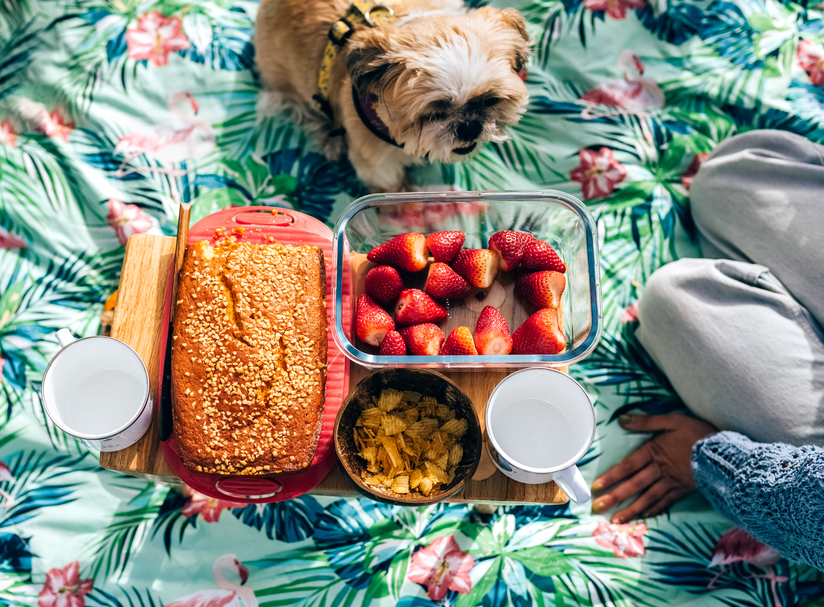Curious if certain food habits—like double dipping and leaving your Uber Eats order on the kitchen counter for hours post-delivery—are super risky or totally safe? And if you don’t wonder about these things, should you?
According to food safety expert Trevor Craig, corporate director of technical training and consulting at Microbac Laboratories, some of these everyday scenarios are innocuous (phew!) while others are basically an open invitation for contamination (yikes). Ahead, discover a few common food safety mistakes you’ll want to correct, stat.
5 food safety tips and guidelines an expert says to keep in mind
1. The five-second rule: risky
Craig says that the five-second rule is simply not a thing—full stop. “It takes no time for massive contamination to happen,” he warns. “Just one bacterium is enough to contaminate something enough to get to a point that could cause illness, and that can happen with just any touch.” You’ll be better off tossing any items and crumbs that fall to the floor, no matter how tasty they may be, or how adamant you are about reducing food waste.
Can’t help yourself? “Think of all the shoes and feet that have been over a surface and what they have stepped in before,” Craig suggests. That vision is probably enough to spoil your appetite (all the while validating my own strictly enforced no-shoes policy at home).
2. Eating and drinking items past their expiration dates: usually safe
Again, we champion limiting food waste as much as possible. Fortunately, if you opt for something in your pantry or fridge a bit past its expiration date, it’s usually not a major cause for concern. “Shelf life on products has very little to do with food safety and more to do with food quality, and those aren’t interchangeable terms,” Craig explains.
But there are a few caveats to keep in mind. “Lots of people handle food poorly,” such as by exposing it to unfavorable conditions and storing it improperly, “and then expect the shelf life to be the same,” he continues. These cases can venture into risky territory for food safety and quality alike. Moreover, some foods and drinks are best to consume closer to their expiration or best-by dates—including dairy, meat, refrigerated raw veggies, bagged lettuce, and prepared foods.
3. Poor kitchen hygiene: risky
According to Craig, many of us could tweak how we handle our food to create a more hygienic kitchen environment. A few habits that get a thumbs down from the food safety expert include:
- Putting a utensil back in a jar after it’s been in your mouth
- Leaving leftovers on the counter for a long time
- Not washing hands or utensils enough
- Not thoroughly disinfecting your sink and dishwasher
Basically, if there’s anything you’d find gross or unacceptable in a restaurant’s kitchen, the same standards should apply to your own.
4. Feeding your pets in the kitchen: potentially risky
As much as you may love your furry friends, Craig strongly advises feeding them in a separate area of your home, such as the bathroom or a small nook in the hallway. “Pet food does not follow the same rules as human food in most situations and runs a risk of contamination,” he explains. “When feeding your pets you may even store the scoop that you use in the food bucket or bag itself.” To avoid icks and even potential illness, he encourages washing your hands thoroughly after handling pet food and not touching anything else until you do so.
5. Eating foods at parties and picnics: use discretion
While you don’t need to avoid communal bites at all costs, Craig advises being more discerning about what you choose to put on your plate. “The food danger zone is rarely paid attention during big events like parties and picnics,” he shares. “I’ll see food stored out in the sun or on the counter with no heating or cooling for hours and people constantly eating and grazing,” which can potentially lead to foodborne illness.
“The food danger zone is rarely paid attention during big events like parties and picnics. I’ll see food stored out in the sun or on the counter with no heating or cooling for hours and people constantly eating and grazing,” which can potentially lead to foodborne illness.
With that in mind, err on the side of caution when it’s time to eat at your next social event (all within reason, of course). Reaching for a slice of freshly delivered pizza is fair game—but it’s worth thinking twice about biting into a burger that’s been sitting out in the sun for a few hours, or scooping up that last bit of hummus without knowing whose hands or saliva have been added to the mix.
The takeaway
These examples only scratch the surface of the food safety mistakes the bulk of us likely make on a daily basis. It’ll work to our benefit to pay closer attention to our food handling behaviors, but we also don’t need to shift into panic mode. “Food is commonly associated with bacteria, which makes so much of food taste good and important to production. Hopefully, that bacteria isn’t the dangerous type, and most of the time it isn’t,” Craig reassures us. He advises against either extreme of thinking our food is totally sterile and bacteria-free, or that everything is laden with salmonella and will compromise your health. Most food safety risks typically land somewhere in the middle of the spectrum, he notes.
Stay connected with us on social media platform for instant update click here to join our Twitter, & Facebook
We are now on Telegram. Click here to join our channel (@TechiUpdate) and stay updated with the latest Technology headlines.
For all the latest Food and Drinks News Click Here

